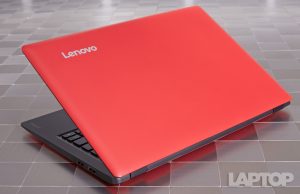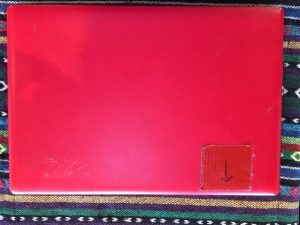At first I was enamored with my new Lenovo laptop. Its peppy red color and compact design were as cute as a bug’s ear and perfect for spontaneous writing venues. And then I tried to open it. The laptop was so sleek that there was no visible latch in front or hinge in the back, forcing me to guess which side was the front. So I logically situated it with the Lenovo logo facing me, the same way I would open a book with the title facing me. No luck. It turns out that from my perspective I have to open the computer backwards. What was Lenovo thinking with this counter-intuitive design? Were they deliberately trying to frustrate me? And then, duh, I realized that the logo was not there for my benefit, either as a gentle reminder of my discerning purchase or an orienting clue to get it open.
I felt like a patsy. Lenovo had co-opted me to optimally display their logo as part of their word-of-mouth marketing campaign.
When I grew up in the 1960s, it seemed that logos and branding were primarily targeted at the individual consumer. Clothing brands were typically identified by the tag inside the clothes. T-shirts were plain white; it was preposterous to think that this reasonably flat surface could be slathered with an ad. The tiny red flag on the back pocket of Levi’s jeans was an isolated exception, along with the leather patch at the waistband that brazenly announced my dimensions. (Oh how I wished I could somehow get my waist size to be less than the pant length, but no luck.) The little alligator LaCoste logo situated above the left nipple was another outlier. Yes, I was proud to wear these brands as status symbols but the logos were discreet. I wasn’t wearing pants with the word “Levi’s” emblazoned across my ass.


To me, the concept of word-of-mouth suggests a spontaneous and organic process, but in our current social media age nothing could be farther from the truth. Marketers rely on Facebook, YouTube and other sharing sites as key components of their strategy. GoPro, a camera that attaches to a helmet, allows skiers to record their exploits. The company encouraged its users to submit their own videos, which could then be virally shared. YouTube is now brimming with consumer-created GoPro clips of extreme sports, moving well beyond skiing to such adventures as shark attacks and mountain biking – and GoPro got all this dramatic content for free. More recently GoPro invited consumers to submit less intimidating videos, such as dogs catching Frisbees, or a baby tossed into the air. The company received even more free content and GoPro lawyers were thrilled that there was no liability if a tossed baby was inadvertently dumped on his head.
There is even a Word of Mouth Marketing Association (WOMMA) that awards prizes for the best campaign. In 2016, “U Kotex” won the WOMMA “Influencer Award” in recognition of its “Period Project” that included “key social influencers” blogging about the unspoken realities of menstruation.
The placement of a logo on a computer may seem like an infinitesimal component of a word-of-mouth campaign, but consider the five year 400-million-dollar contract Microsoft signed with the NFL to promote its Surface Pro tablet as the official “sideline technology.” This sponsorship was better than a car or snack endorsement because viewers could see players and coaches using the tablet in real time. Football fans may remember the sight of a studious Peyton Manning on the sidelines, madly flipping through grainy photographs of the opposing defense (an opportunity that Jay Cutler, the pouty Bears quarterback, never seemed to take full advantage of).
Now fans could watch Peyton efficiently scan his Surface Pro. Microsoft didn’t need to sign an individual deal with a social influencer like Manning; the NFL had co-opted him into being a spokesperson. Unfortunately, the Surface Pro logo was often obscured.
There were other glitches. The announcers mistakenly referred to the tablet as an iPad, and a frustrated Bill Belichek was seen chucking his balky Surface Pro into the garbage.

However, at least once a game, presumably as required by contract, the cameras cut to the shadowy play-callers high up in the booth. Though we cannot see their faces, we can easily see their well-lit tablets, situated at the perfect angle to highlight the appropriately oriented Surface Pro logo.
Lenovo would be very disappointed in me. I will never be mistaken for a social influencer. I primarily use my computer in isolation, or maybe at the library where I share space with drowsy retired men idly thumbing through periodicals. It is laughable to think that I might stand in front of a rapt audience and triumphantly display the Lenovo brand as I pry open my tablet. But even so, I don’t want any misperceptions that I am pimping for Lenovo. A piece of red duct tape did the trick. I then added an arrow to remind me how to open the computer.
Follow Liza Blue on:
Share:




